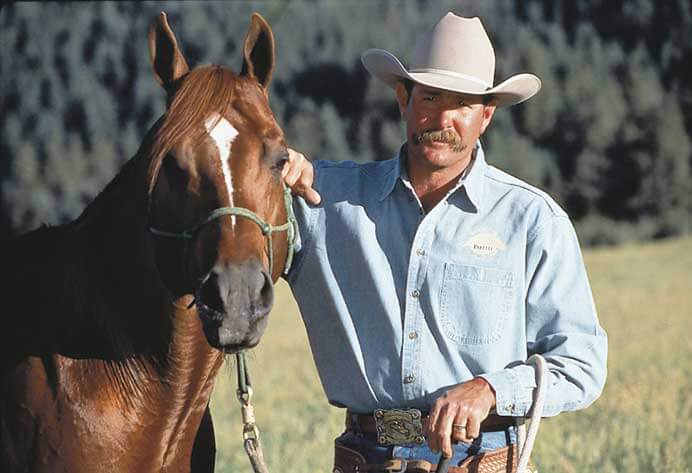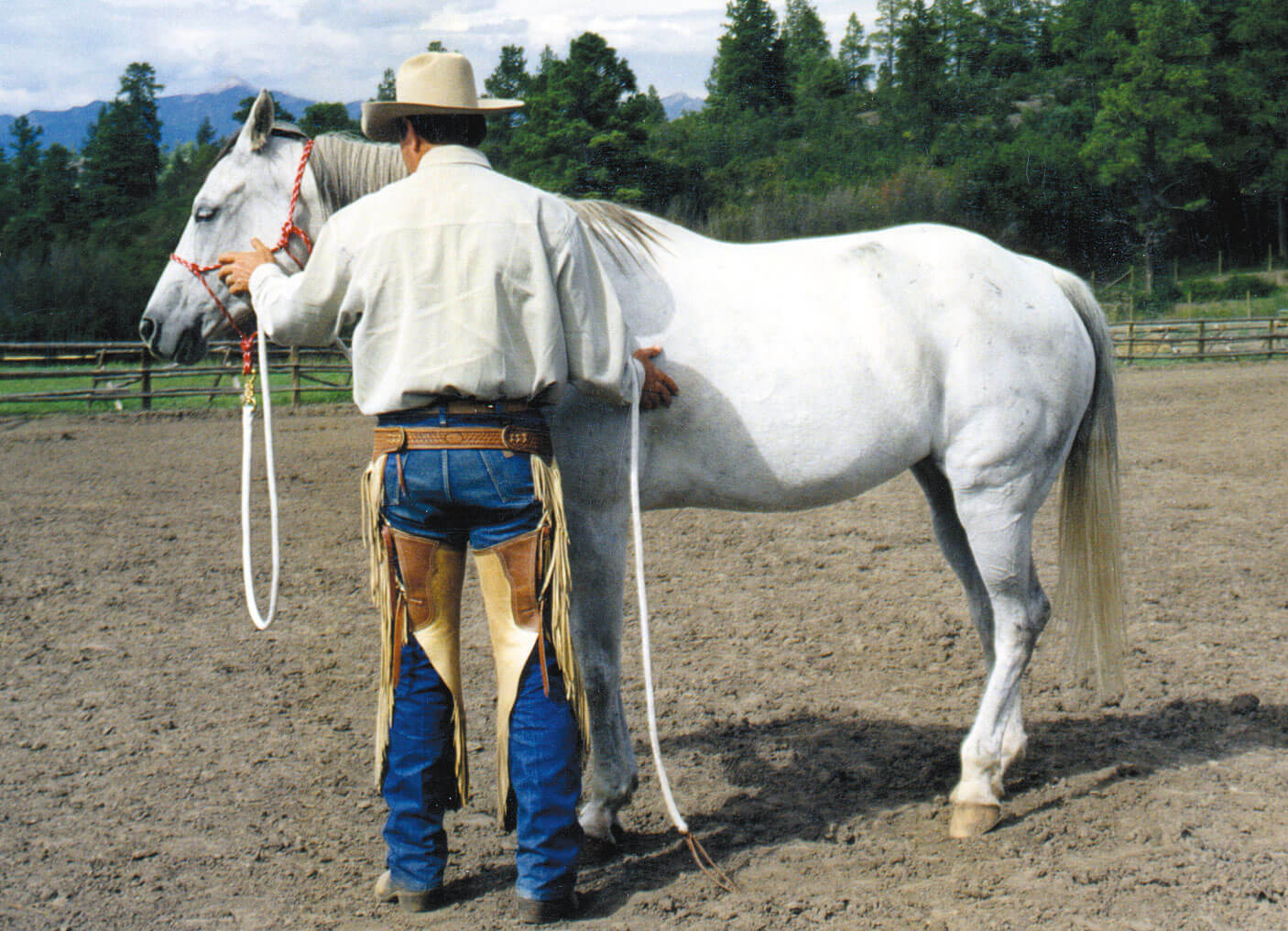Game #2 in the Series of the Seven Games
Last month we talked about the process of developing communication with a horse, and how yielding from physical pressure is a major factor. The two basic ways are steady, physical pressure and rhythmic, nonphysical pressure. A horse will move away from rhythmic pressure more easily than from steady pressure. His flighty nature makes him more inclined to move away from things like waving hands. But he will find it easier to lean into your leg, your hands or the halter. That’s why the Porcupine Game can be a challenge.
As you ask your horse to yield, the pressure starts with a determined look and a soft touch becomes progressively and smoothly more insistent, making it increasingly uncomfortable for the horse if he doesn’t move. The INSTANT the horse responds by moving away, or even tries to respond by shifting his weight, immediately release all the pressure! It’s not the pressure that teaches. It’s the release from pressure that tells the horse he did the right thing.
To sensitize a horse, you need to be ready to release as soon as he tries to do what you ask. If you keep pressing after the horse has responded you will de-sensitize him and he’ll become dull. He will lose incentive to do what you want, and it will take more and more pressure to get him to respond at all. Comfort is a major motivational factor for a horse, and you need to show him how he can attain comfort by yielding to pressure.
By coming on too strong without enough feel for the horse or not following through to be effective, the horse can become dull and disrespectful.
A few years ago in Europe there was a young girl who had a Swiss mountain horse. These horses are mostly used for packing and driving and are not the most sensitive creatures in the world. They’re pretty thick-skinned because they’ve learned to get along by pushing against the pressure of the bit and driving collar up steep mountains. This particular horse took the girl sand skiing whenever he pleased. He also had a trick of yanking his head around and literally flinging the poor girl from one side to the other. You could see that the horse had made a game of it. He wasn’t being mean, but he’d play games to get his way.
When it came to the Porcupine Game, this horse was not going to move. That little girl was pitched against his side, pushing her fingers into his skin with all her might and he just stood there and yawned. I came to help her and took out my pocketknife as I approached and concealed it in my hand. I rubbed his side, pressed very lightly with my fingers, then pressed a bit harder and a bit harder again and finally introduced the flat screwdriver tool from my pocket knife and kept slowly increasing the pressure. That horse lifted his head, widened his eyes, grunted and stepped away. He couldn’t believe it! I released the pressure and rubbed him, then began again with the light pressure of my fingertips. Again, I ended up having to use the screwdriver head to be effective, but the third time I asked, that horse moved with just a little bit of pressure from my fingers and continued to do so after that. All he needed was to know that I was going to be effective. It was up to him to pay attention to the lighter requests. ·
If you are not effective, you are just nagging your horse. If you don’t find a way to be effective you will constantly have to use heavy amounts of pressure to get anything done and the horse will  wind up aggravated and dull.
wind up aggravated and dull.
Horses are always effective with each other. They always come on slowly but are ready to follow through. The untrained eye often misses these subtle messages and that’s why people get bitten, kicked and struck. When one horse invades another horse’s space, the second horse lays back his ears (warning #1), tosses his head (warning #2), snakes his neck (warning#3), then bites a chunk of flesh out of the other horse’s neck if he’s still there. The invading horse either didn’t notice or didn’t believe the other horse’s signals of intent and wound up with a bite. Next time, that invading horse will recognize those earlier signals!
Teaching your horse to be light and responsive
Every time you prepare to porcupine your horse, you need to rub him first. After you’ve pressed and he responds, you need to rub that spot again. This is especially important when he is just learning how to move away from steady pressure.
If you just start prodding and pressing and never rub before or after, your horse will become pretty defensive. When you approach him or put your hand out toward him, he’ll start to move away trying to escape ungracious pokes. This is especially common with sensitive horses.
Rubbing is a form of the Friendly Game (#1 of the Seven Games) and is vital in the horse-human relationship. If you rub then apply steady pressure in mounting increments, release the instant he moves and rub again, you’ll be well on your way to developing a good physical communication with your horse.
Let Me Count the Ways
There are many directions you can ask a horse to yield in the Porcupine Game:
- Backwards
- Forwards
- Left (hindquarters and forehand)
- Right (hindquarters and forehand)
- Up
- Down
You can ask him to yield in each direction from different areas of his body. You could also introduce a variety of obstacles and specific tasks to challenge you and your horse. Let your imagination run wild!
Instead of starting with your fingertips, you can accelerate the Porcupine Game by using a PNH Carrot Stick. Four feet long, stiff and sturdy, the Carrot Stick • enables you to apply pressure to your horse’s chest, neck and hip while staying out of range of trouble. Because it is always steady and strong, it is far more effective than just your fingertips. Since I started teaching the Porcupine Game with a Carrot Stick, the results are much faster. Use the Carrot Stick to teach the concept, then your fingertips to refine the feel.
Opposition Reflex
Many of you know what this is but perhaps didn’t know there was a term for it. Opposition Reflex is a defensive reaction where a horse opposes pressure and pushes into it instead of moving away from it. Like when you try to push your horse off your toe and he leans his shoulder into you and pushes down harder.
It’s important to know that this is not disobedience. It’s an instinct and a totally natural reaction for a horse. It’s not even a response. It’s a reaction because the prey animal instinct sometimes lives just below the surface.
A horse that bites or kicks when you first play the Porcupine Game is reacting with Opposition Reflex to the pressure. The worst thing you could do at that moment is punish him. The next worst thing is to release the pressure. Unless you are in danger, keep up steady pressure until you get a positive response. Otherwise, you will teach your horse to react dangerously to pressure. The key is to stay passively persistent in the proper position.
Hands That Close Slowly
One very important savvy secret for developing great feel is having hands that close slowly and open quickly. Our nature makes us want to grab quickly with our hands, or to use sudden movements, even to poke and shove rather than press steadily and politely.
Quick-closing hands produce horses that brace, are dull, or that overreact. Watch great horsemen and you’ll see a gracefulness about the way they use their hands. Their fingers close slowly, one by one and they open quickly when the horse is right. Hands like these are good communicators. They have feel, and horses really appreciate them. With hands (and legs) like these, the communication with your horse becomes almost imperceptible.
Want to know more? You will find more detailed information on the Porcupine Game, and any of the Seven Games in the Partnership pack, part 1 of Pat Parelli’s Savvy System. Call Parelli Natural Horse•Man•Ship at 1-800-642-3335 or visit www.parelli.com for a free brochure.
From April 2003 Issue

Pat Parelli is an American horse trainer who practices natural horsemanship and founded the Parelli Natural Horsemanship program.






